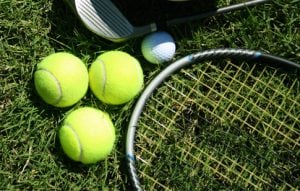Tennis and Golfer's Elbow
Tennis Elbow vs. Golfer's Elbow: The Causes, Symptoms & Treatments
Late summer is prime time for tennis and golf. In fact, two of these sports’ most anticipated and highly watched events occur every year in August. With the 2015 PGA Championship now over, the tennis world is gearing up for the US Open, which begins on August 31. Unfortunately, with more people hitting the tennis courts and golf courses, late summer is also the season for two common types of sports injuries: tennis elbow and golfer’s elbow.
Tennis Elbow and Golfer's Elbow - What's the difference?

While many people are familiar with the names of these conditions, there is less widespread understanding about how they differ. Both tennis elbow, or lateral epicondylitis, and golfer’s elbow, or medial epicondylitis, are injuries to the tendons attaching your forearm muscles to the bone at your elbow. The “epicondyle” part of epicondylitis refers to the bony bumps or protrusions at your elbow.
Lateral epicondylitis affects the tendons attached to the outer (lateral) side of your elbow, which are connected in turn to the muscles that extend your wrist backward and straighten your fingers. Medial epicondylitis affects tendons connected to the inner (medial) side of your elbow, which are attached to the muscles that flex your wrist and contract your fingers when you grip something.
Both injuries are usually the result of repetitive strain on the tendons, and although you don’t have to be a golfer or tennis player to experience them, the repeated forceful motions involved in both sports make them very common.
Symptoms
The anatomical structures involved in tennis elbow and golfer’s elbow are very similar and the symptoms are also similar, but they appear on opposite sides of the elbow and arm.
Common symptoms of tennis elbow include:
- Pain that radiates from the outside of your elbow and down your forearm
- Tenderness on the outside of your elbow
- Weakness in your forearm or a weak grip
- Pain when you grip things, twist something or, if you play tennis, especially with backhand strokes
Golfer’s elbow symptoms are similar, but occur on the inside of your arm and include:
- Pain and tenderness on the inside of your elbow
- Pain that radiates down your arm from the inside of your elbow
- Weakness in your hand or wrist
- Numbness or tingling in your ring and little fingers
- Pain when you grip or twist things
- Pain when you flex your wrist
Both tennis elbow and golfer's elbow symptoms usually start gradually and get worse over time.
Causes
Both conditions are types of tendonitis, or inflammation of a tendon, and both are commonly caused by overuse. This may be due to excessive force on a regular basis (like hitting a tennis or golf ball) or due to other repetitive activities that involve the forearm muscles. The tendons over time can progress from inflammation, to partial thickness tears, and finally full thickness tears. Painters, plumbers, and carpenters or anyone performing repetitive gripping and lifting activities are also prone to both tennis and golfer’s elbow.
Treatment
Fortunately, most cases of tennis elbow and golfer's elbow respond well to conservative treatments. Surgery is usually not necessary, although complete recovery can take weeks or even months, depending on the severity of the condition. As with other forms of tendonitis, the most important aspect of treatment is to reduce the amount of strain on the affected tendons. This may include resting the arm, using a brace or athletic taping, wrist splints, and once healed, correcting improper technique/form to prevent the recurrence of the injury.
Other treatments may include:
- Ice – depending on the severity, icing the affected area may be helpful for reducing pain and inflammation
- Anti-inflammatory medications – medications such as ibuprofen or naproxen are commonly recommended
- Stretching exercises – exercises which stretch the involved forearm muscles can help reduce strain on the inflamed tendons
- Physical therapy – stretches and strengthening exercises through physical therapy can aid and accelerate the recovery process
- Platelet Rich Plasma (PRP) – “blood spinning” therapy is another option you may have heard of; this is done for many professional athletes
- We offer the best system in the market at £.350 for self pay by Stryker Regen system
- Cortisone injections – These are now contraindicated and not recommended by NICE
- Surgery – if all else fails, surgery yields high success rates
